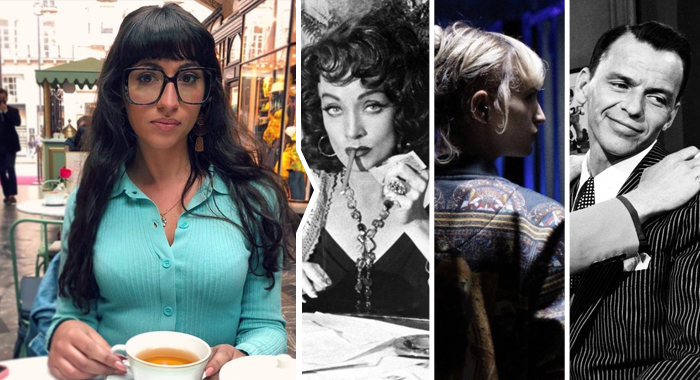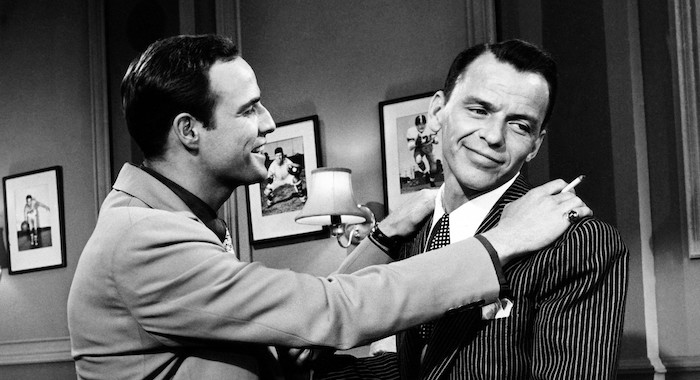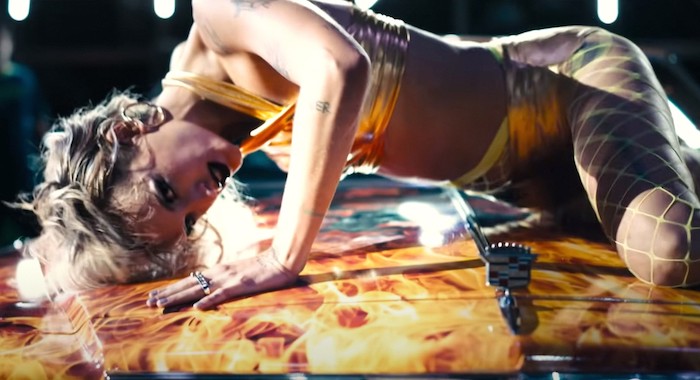
(Photo by United International / Neon / Metro-Goldwyn-Mayer)
“Know Your Critic” is a column in which we interview Tomatometer-approved critics about their screening and reviewing habits, pet peeves, and personal favorites.
Christina Newland absolutely adores classic cinema. Her descriptions of style, of the expressionism in Rumble Fish or the fashion in Goodfellas (the latter of which she calls her “weird comfort blanket movie”), is almost romantic. Of course it is. Newland is, in many ways, an expert in filmic wants and aesthetics – in desire, imagination, and how each manifests for audiences.
She Found It at the Movies, an anthology Newland edited and published in 2020, is filled with personal essays about the many ways we covet what’s on screen. The book is inspired partly by Pauline Kael’s I Lost It at the Movies and takes Laura Mulvey’s seminal essay “Visual Pleasure and Narrative Cinema” as a philosophical jumping off point.
And how could it not? In 1973, Mulvey articulated a longstanding pattern in visual storytelling, as Newland described in an interview with Rotten Tomatoes: “Women were there to be passive, be looked at, whereas men – both behind the camera and on camera – were the active ones. They were either actively looking or they were actively doing.”
The question Newland and the writers in her book are interested in is this: “Presupposing that a lot of movies aren’t made for us – as people outside of cis white straight men – what does that mean when we watch movies that aren’t meant for us, but we still find things?”
“We sort of parcel things out for ourselves,” she suggests. “It’s that kind of thing when you’re sneaking little things away from movies. How do we work through that as movie lovers?”
Christina Newland is Film Critic for The i Newspaper. She publishes a newsletter, “Sisters Under the Mink,” and in 2020, she published her first book – an essay anthology titled She Found It at the Movies: Women Writers on Sex, Desire and Cinema. Find her on Twitter: @christinalefou.
Oscars are right around the corner. Do you have a nominee or nominees that you’re rooting for?
Oh yeah, definitely. The Power of the Dog. It’s Jane Campion’s first film in over a decade. I love Westerns, and I just felt like this was such a smart, subversive take on the genre, and in a way that didn’t feel telegraphed. It really felt organic and thoughtful.
That and Licorice Pizza, which I’ve seen, I think, three times now. It’s like sunshine in celluloid form.
What is your ideal movie-watching scenario?
I have a local cinema called Broadway Cinema in Nottingham, England, and it feels like being at home, in a sense. I know everyone that works there. You can get a nice bit of red wine and sometimes some chocolate.
What is your most memorable theatrical viewing experience?
I can remember when I first moved to England – I’m American; I moved to England when I was 18 – and my husband took me to see a screening of Safety Last, the Harold Lloyd movie. And it was the first time I ever saw a silent film on the big screen. They had a piano accompaniment there, and it was packed.
There were people of all ages laughing at this film, which was over 100 years old. That was amazing; that was really formative. I’ve always loved classic films, but I guess I hadn’t realized that a silent film could be as funny now as it was then.

(Photo by Warner Bros., Courtesy Everett Collection)
Who was the first critic that made you excited to write about movies?
I always feel like a broken record when I say this, but it’s just true: Really, really something that was super formative for me was reading Molly Haskell’s From Reverence to Rape – her great book about the depiction of women throughout Hollywood history up to the ’70s, when she wrote the book. And Pauline Kael.
I found those books – books of Kael’s criticism and From Reverence to Rape – in my university library when I was studying film and English. I love so much Kael’s piercing analysis and lyrical way of writing about actors and performance. It’s something I’m still, you know, totally in love with. The combination of the personal and the professional in her writing was very inspiring to me.
What do you think is the biggest misconception about critics?
It feels like people think that critics are there to spoil their fun, or are coming into films with the expectation of taking them down a notch or, you know, coming with some sort of agenda. Generally speaking, nothing could be further from the truth.
People who are professional critics are in it not because there is “the big bucks” as a rule – it’s not a particularly great paid profession – it’s because they love movies. I mean, they really, really love movies.
I’m always disappointed when a film doesn’t live up to what I’d hoped for it. Sometimes the worst ones are the ones that you’re really, really excited for. And equally, it’s a great pleasure when you go into films that aren’t necessarily what you think will be your cup of tea. Like, I’m not massively into superhero stuff, and then really, really enjoyed The Batman. It’s always a pleasure to be surprised by a film, and conversely, always a disappointment to find it wanting it some way.
The idea that critics are professional naysayers, or they want to hate things, couldn’t be further from the truth.
What are you most proud of in your career so far?
Certainly She Found It At the Movies, the anthology that I edited and was published in 2020. I was very proud of all the writers involved with that, because the nature of it was that it involved certain kinds of… You’re talking about sex and desire and they’re personal essays. I’m quite proud of all of them, and proud of myself for making it happen.
And I’m quite proud of, just last year, I started a newsletter called “Sisters Under the Mink,” which is about the depiction of women in crime movies and TV, everything from serial killers to mob wives.
What, if anything, do you consider required viewing?
I try not to be the person that, whether I’m talking to cinephiles or whatever, like, “Oh, you haven’t seen this?” I try to be open and to let people come to things in their own time and through their own taste, and not being influenced by people telling them, “You have to see this.”
Having said that, being into classic films in the way I am, of course I would really like people to seek out some of the older films and to realize that perhaps some of their preconceptions about them being antiquated and dated in some ways aren’t as universally true as you might think.
I don’t think you can go wrong with Cagney films in general. I would say The Public Enemy is a film that’s almost timeless – it’s like a punk song of a movie, you know? It’s short and sharp and nasty, and it doesn’t feel nearly as antiquated as it might for a film on the cusp, basically, of sound cinema in 1931.

(Photo by MGM / UA Home Entertainment / Metro-Goldwyn-Mayer / Courtesy Everett Collection)
What’s a Rotten thing you love?
Reginald Hudlin‘s movie from 1996 called The Great White Hype. It’s a boxing film parody about racism and greed in boxing, starring Samuel L. Jackson as what is almost certainly Don King, or a Don King-like figure.
It seems silly on the face of it. It also stars Peter Berg as this sort of up-and-comer that they, because he’s white, they try to sort of hype him up as going to beat the best Black champion, sort of vaguely based on Floyd Mayweather. Berg is useless, but they hype him up so much that he gets to believing that he might be able to win. Of course it ends terribly for him.
Maybe you have to be a boxing fan as well to kind of see how on the money it is, but I think it’s hilarious.
What do you think makes a good movie?
Ooh, it could be so many things. I seem to be really drawn to films that are either extremely expressionistic black and white, like Touch of Evil, the Orson Welles film, or like Francis Ford Coppola‘s Rumble Fish – that sort of really kind of smoky, expressionistic, black and white. Or things which are like blaring classical Technicolor, like Singin’ in the Rain or Gentlemen Prefer Blondes.
What they have in common, besides the visual, is that they’re all in such deeply etched, unique worlds that really just pick you up and drop you in the tone and the spirit. Whether it’s a dusty border town near Mexico in Touch of Evil or these leather-jacketed psychopaths hanging out on Lower East Side bars in Mean Streets. The best films for me, the really good films, drop you right in that environment.
What about your favorite classic film?
That’s kind of just like impossible. There’s so many obvious classic ones that I adore. Like Sunrise, the silent film, or Singin’ in the Rain, or, you know, The Godfather Part II. Any of those films.
Something that people love, but I don’t think people talk about as much as a top-tier great classic film, is Joseph Mankiewicz‘s Guys and Dolls, the musical. I love it.
That old connection in the 1920s, ’30s, ’40s where a lot of the great tough-guy actors were also dancers and came from Vaudeville or a dancing background. You get that with Guys and Dolls, you get that with Frank Sinatra and Marlon Brando. You get that combination of the great Technicolor MGM musical and the beautiful sound stage – you know, that very patently artificial sound stage in New York City – but then you get this kind of like tough-guy, old time-y thing about it, which I find very, very charming.

(Photo by TITANE, Agatha Rousselle, 2021. © Neon /Courtesy Everett Collection)
I want to ask you about She Found It at the Movies. Each writer looks at different gendered and sexualized ways of approaching gazing and identification. The male gaze and the female gaze are often framed in opposition to each other, but what have you found as a critic, personally and professionally, that proves that gazing is not actually binary?
This is really complicated question. It’s one of those ones that almost you feel like you can’t totally do justice to out loud.
It’s definitely not as simple as who’s doing the looking, as in who’s behind the camera, and how that person’s being filmed. Women can objectify other women, men can objectify other men, and so on.
I wrote about it, about Jean-Claude Van Damme – great action star of the ’90s – and how he often worked with Roland Emmerich, who’s a gay man, and even in films not directed by Roland Emmerich, Jean-Claude Van Damme was keenly aware of the fact that he had an audience outside of just straight men. A lot of gay men and a lot of women, straight women, did like him. He had a really nice body, and he was really keen on showing it off. Loads of bare bum shots of him – more than anyone needs in an action movie. It goes above and beyond the expectations of a big hench action star, manly action star. How do we then… Well, whose gaze is that, looking at him? I think it’s complicated.
There’s sexual desire and there’s identification – sometimes they overlap. You begin the book by saying that James Dean was one of your first examples of onscreen desire. Have you ever seen yourself on screen, and if so, what did you identify with about that character or story?
James Dean is a great example. I tended to more look for ways that I could shore myself up by copy-catting or imitating some affectation or confidence or walk or something, of some of the people that I see in the movies. Dean, when I was a kid, he seemed very cool. Now looking back, he seemed just as confused and alienated as every other teenager.
Somebody that – I don’t see myself in her at all, don’t get me wrong – but I look up to is Jeanne Moreau, the great French actress who, in everything she’s in, just has this sort of world-weary, seen-it-all-before energy. She has this great elegance and this intelligence in the way she carries herself. She’s sexy and chic, but she’s not a man’s plaything ever. And yeah, there’s such strength that radiates from her. It’s a very feminine strength, and I admire that. That would be something I would like to emulate in life… Jeanne Moreau.
Are there any recent releases that have engaged any kind of gaze in ways that were interesting to you?
Titane, definitely. The way that it plays with the gendered gaze, with gender-swapping and trans-ness, is revolutionary and very, very smart.
A Dutch film from 2019 called Instinct. It’s directed by Halina Reijn – she’s a Dutch actress that worked several times with Paul Verhoeven; she was in Black Book – and it’s her directorial debut. The film is about a woman who works as a psychiatrist in a sex offender unit and begins to form a really complex and queasy and sexy relationship with one of the people locked up in there. She begins to fantasize about him. It has some similarities to [Verhoeven’s] film Elle, where it’s very much about like shifting consent and desire, and how you reconcile that kind of despair against your feminist impulses.
I would encourage people to seek that out if they don’t mind a slightly uncomfortable viewing experience, but a very thought-provoking one.
That’s a key part of the introduction to your book – reckoning with the desires that are complex and maybe “unseemly.”
Absolutely. I think film criticism being so male-dominated for as long as it has been, I’m very interested in what’s unseemly, especially where women are concerned, and women critics are concerned.
Christina Newland is Film Critic for The i Newspaper. She publishes a newsletter, “Sisters Under the Mink,” and in 2020, she published her first book – an essay anthology titled She Found It at the Movies: Women Writers on Sex, Desire and Cinema. Find her on Twitter: @christinalefou.